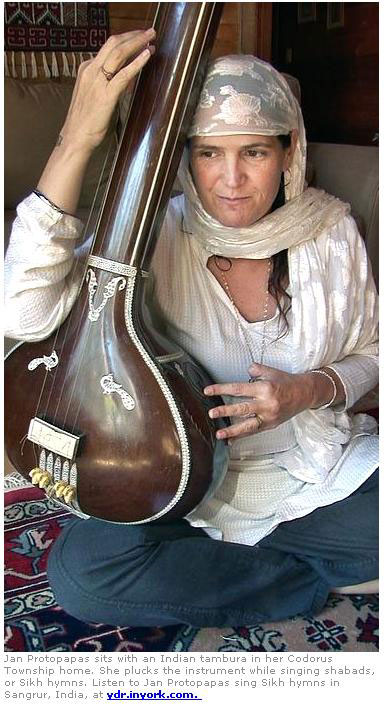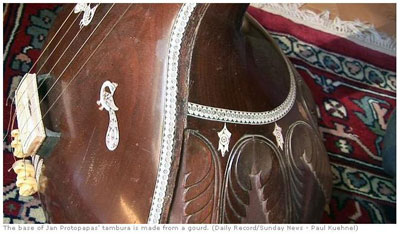 Jan Protopapas sits cross-legged on the floor and covers her long, mahogany hair with a gauzy, pearl-white scarf.
Jan Protopapas sits cross-legged on the floor and covers her long, mahogany hair with a gauzy, pearl-white scarf.
She leans the bulbous base of her tambura on her knee and, with a lover's familiarity, cradles the instrument's 4-foot-tall neck between her shoulder and head.
Eyes closed, she turns an ear to the open strings. Her fingers pluck, and a sustained, harmonic buzz resonates.
She sings: "Janam janam kay dookh nivaarai sookaa man saDhaarai . . ."
The poetic hymn-singing, a form of worship in the Sikh faith, is what drew Protopapas to this mystical religion dating to 15th-century India.
Protopapas, 46, a middle-school teacher living in Codorus Township, excels at gurmat sangeet -- the art of singing and playing the hymns of the sacred Sikh scripture in the prescribed rágs, or melodic modes of classical, medieval Indian music.
Many Indians have forgotten these modes, which fell out of use with the rise of commercial culture. Protopapas learned the modes during years of study in the Punjab region of northern India and is now working to transcribe the music in Western notation.
Born in Canada and raised mostly in Lancaster County, Protopapas is somewhat of an anamoly among Sikhs in America -- most of whom are first- and second-generation immigrants from India. She adopted the faith as her own two years ago while studying Sikh music across Punjab.
A faith largely unknown in the U.S., Sikhism is based on the teachings of 10 gurus. Sikhs consider their holy book -- a compilation of teachings and verse from the gurus and selected Hindu and Muslim saints -- to be the final guru and the living embodiment of God's teachings.
Known as the Guru Granth Sahib, the 1,430-page text marks its 300th anniversary this month. The hymns Protopapas sings are drawn from the holy text.
"The themes reflect everything in the Sikh faith -- the seasons, birth, marriage, death, nature, everyday life," said Protopapas, who speaks Hindi, Urdu and Sanskrit.
She performs at Sikh music festivals, gurdwaras (Sikh temples) and in private homes. She teaches vocal music at a Sikh institute for children in Fairfax County, Va., and travels to perform in Punjab once or twice a year.
"Her singing enables one to reach a place with God -- a point of harmony with universal peace," said Joan Maruskin, a friend and Methodist pastor.
"Even though, in many cases you don't know what she's singing, by concentrating on the song, it allows one to touch a place of personal peace and quiet."
Protopapas' interest in the music was purely academic at first. She studied classical Indian music, philosophy and education systems in Punjab on and off for more than 20 years. In 2006, she spent
Find more news about faith, values and belief locally and nationwide in our new "Faith Life" section
the year recording Punjabi ragis and interviewing the musicians about the rágs' significance.
On trains, in desert towns and on sidewalks, Protopapas interviewed Sikhs throughout Punjab about the music. She'll compile the research for her doctoral dissertation in ethnomusicology at the University of Maryland at College Park.
Toward the year's end, Protopapas decided to make a personal commitment to the faith she was studying so intimately.
"I wanted to sing. And if I wanted to do this and be embraced by Sikhism, I had to embrace it myself," she said.
"Studying Sikhism has taken me to a deeper understanding of the power of praise through song. . . . It's truly a music ministry -- sharing the hymns through rágs were the way of sharing the message" in the early days of the faith.
Sikhism developed in the 15th century in reaction to the caste system and other social ills in the Muslim and Hindu societies of what is today Pakistan and the Punjab region of northern India.
Sikhs profess faith in one God, human and gender equality, universal love and honest work, emphasizing the importance of charity and justice. Protopapas, who was given the name Gurleen ("immersed in God's name") Kaur at her initiation (or baptism), grew up in a Christian home, daughter of a Canadian mother and American father who met as students at Messiah College in the 1950s.
Protopapas, who was given the name Gurleen ("immersed in God's name") Kaur at her initiation (or baptism), grew up in a Christian home, daughter of a Canadian mother and American father who met as students at Messiah College in the 1950s.
Protopapas wears an iron bangle on her right wrist -- one of the symbols of the Sikh faith, which calls adherents to distinguish themselves from society in appearance and conduct. The bangle represents the unbroken link to God -- mind, body and soul.
The faith's other formalized symbols are: uncut hair, symbolizing the flow of life and acceptance of God's creative beauty; a comb concealed in the hair to remind Sikhs of their stewardship duties; a ceremonial dagger representing the fight against injustice; and special undergarments to symbolize the Sikh belief in physical activity, social volunteerism and sexual fidelity.
Protopapas was never attracted to the image of Sikhism but rather its music, she says.
Lacking a Sikh community locally for support and communal worship, Protopapas has adapted her practice so it remains meaningful and spiritual (the closest gurdwaras are outside Reading and in Rockville, Md.).
"You don't have to be a yogi. You can live in the world. I can apply it here,"
she said of the Sikh teachings.
"It would be lovely to live among brethren, but here I find the guru within everybody."
771-2024; [email protected]
MEET JAN:
Name: Jan Protopapas
Age: 46
Born in: Fort Erie, Ontario, Canada
Lives in: Codorus Township
Family: Daughter Helena, 18; and son Yiorgo, 13
Occupation: Teaches English as a second language at Edgar Fahs Smith Middle School in York
Education: Bachelor's degree, South Asian studies, University of Wisconsin; master's in English as a second language, University of Maryland, Baltimore County; pursuing a doctorate in ethnomusicology, University of Maryland at College Park

